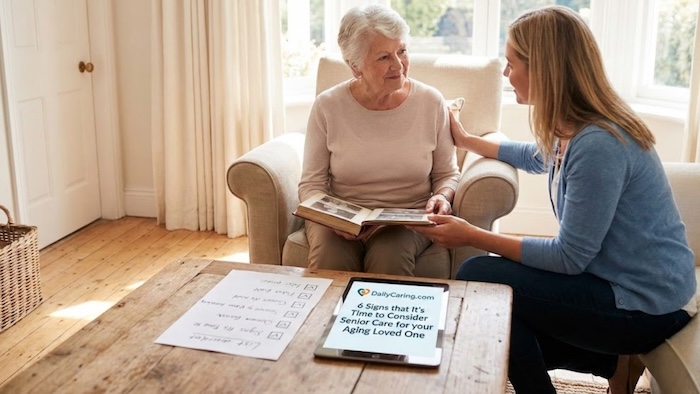Hiring and managing home care for your loved one can be challenging.
It’s often the first time they’ve needed this type of service, and unfamiliar situations could arise.
To create a positive, practical caregiving experience, it’s essential to understand common concerns and how to address them.
By fostering open communication, setting clear expectations, and actively engaging with home care agencies, families can navigate challenges and ensure the well-being of their older adults.

How to Handle Home Care Issues
In this guide, we will dive into the top 9 topics commonly encountered in home care situations and share advice on how to handle them.
1. Identifying good vs. problematic home care agencies
Selecting a reputable home care agency is crucial for a positive caregiving experience.
How do you find a caregiver with the right skills and personality to ensure a comfortable and supportive environment? Questions about home care often center on qualifications, experience, and compatibility.
In addition, indicators of a reputable home care agency include transparent communication, rigorous caregiver screening, and personalized care plans.
Conversely, red flags include a lack of responsiveness, inconsistent caregiver assignments, or inadequate training programs.
Client testimonials and reviews can also provide valuable insights into a home care agency’s reputation.
2. Finding out about cultural fit
When interviewing home care agencies, ask whether they train their caregivers in cultural competence so they can provide respectful care to people from cultures different from their own.
When talking with potential caregivers, ask about their experience with your older adult’s cultural preferences, beliefs, and values.
3. Building a strong caregiver-client relationship
Establishing a positive relationship between the caregiver and your loved one is key to the success of home care.
Encourage open communication, set clear expectations, and facilitate activities that strengthen the bond between the caregiver and your loved one.
Regularly checking in and asking for feedback or concerns from both the caregiver and your older adult also helps build a supportive, collaborative environment for everyone.
4. Managing caregiver distractions: Mobile phones
A common concern in home care situations is whether the caregiver is more engaged with their mobile phone than with the person they are caring for.
To address this issue, before the caregiver begins caring for your older adult, establish clear expectations for device use during working hours.
Make it clear that you expect the caregiver to prioritize your older adult’s needs and to notify you if they have any concerns or issues that arise.
5. Addressing issues with caregivers
If issues come up with your older adult’s caregiver, open communication is essential.
The sooner you address concerns and clearly express your expectations, the better. The first step is to talk with the agency and work together to find solutions.
Agencies often have procedures in place to handle such matters. Understanding these processes can bring you peace of mind and lead to smoother resolutions.
6. Recognizing warning signs: When to switch home care providers
Identifying when a change in home care providers is needed can also be a challenge.
Watch for warning signs such as frequent tardiness, lack of communication, sudden changes in your older adult’s mood or health, refusing to address concerns, or a noticeable decline in the quality of care.
It may take some work and disruption to change agencies, but if your older adult isn’t getting the care they need or if you can’t depend on the caregiver, making a change could be the best solution.
Regular check-ins with both the caregiver and your older adult can help you understand how things are going and address any emerging issues before they escalate.
7. Adapting to changing care needs
As your loved one’s health and needs change over time, effective care transitions become necessary.
Encourage open communication with their caregivers and home care agency to accommodate changing requirements.
Having flexibility in care plans and conducting regular reassessments ensures that the caregiving approach continues to meet your loved one’s changing needs.
8. Balancing senior independence and safety
Striking the right balance between promoting independence and ensuring safety is a common challenge in home care.
What modifications can be made to the home to enhance safety without limiting your loved one’s autonomy?
Collaborate with caregivers to develop personalized care plans that respect your loved one’s autonomy while addressing safety concerns.
Regular assessments of care needs help you adjust the level of support based on your older adult’s changing capabilities.
9. Understanding home care costs
Families need a clear understanding of home care costs so they can create a care plan that fits their budget and meets their older adult’s needs.
First, contact the home care agency to learn about their fees and any minimum requirements.
Also consider the cost of any needed home modifications or medical equipment.
Then, explore available financial resources, including insurance, government assistance, and long-term care policies.
Final Thoughts About Home Care Challenges for Aging Adults
Remember, facing these challenges is not a sign that you’re failing, it’s proof that you are deeply engaged in finding the best possible care for your loved one. While the path is rarely straightforward, each challenge you navigate strengthens your skills as an advocate and a care manager. You are not expected to have all the answers.
The goal is progress, not perfection. Continue to trust your instincts, lean on your support network, and celebrate the small victories. Your dedication is the steady anchor that makes your loved one’s safety and comfort at home possible.
Recommended for you:
- Affordable Home Care: 8 Ways to Lower Senior Care Costs
- 3 Tips to Choose Between Assisted Living vs In-Home Care
- Medicare PACE Pays for In-Home Care
About the Author

Lance A. Slatton CSCM – Known as “The Senior Care Influencer” is a Writer, Author, Influencer, and Healthcare professional with over 20 years in the healthcare industry. He is a senior case manager at Enriched Life Home Care Services in Livonia, MI. Lance A. Slatton is also the host of the award-winning podcast & YouTube channel All Home Care Matters.












